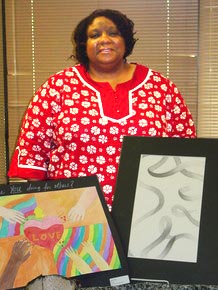
Personalities
The Complete Picture
By: Duane St. Clair

A planned one-hour interview with a light-hearted but still serious Yolanda Brown easily lasts two hours in the dormant-for-the-summer classroom where she teaches art at Dublin’s Davis Middle School.
Next Nov. 4, she’ll be honored as middle school art teacher of the year by the Ohio Art Education Association at its annual meeting in Columbus. Quickly she points out that it’s a shared honor this year and that Mary Baine of Baker Middle School in Fairborn is the other honoree. Yolanda’s says only a handful were nominated.
Written descriptions of art education, its goals and significance, often are not quite as revealing as is a chat with Yolanda, whose relaxed demeanor and candid conversation reveal the charm and dignity she brings to her charges, their parents and the Dublin school system.
Talking with Yolanda, who has a master’s degree in art education from Miami University, reveals who she really is and what she’s about in a half-dozen classes a day for sixth and eighth graders. First and foremost, she sees art as a valuable tool in school and life, regardless that a person is not an artist. For her art is fun, something she has done since childhood, beginning with making coal chalk marks on her grandparents’ sidewalk. She notes that art impacts us in many ways by depicting history, in Power Point presentations, advertising, exhibitions, home decorating, the list goes on.
She has taught art seemingly forever and since 2002 in Dublin, all but one year at Davis. “I like middle school kids. I’m especially in love with sixth grade kids. This is their first real academic independence. They never had a locker … changed classes every hour or had a different teacher for every subject. They’re eyes are bright and shiny and their hearts are open. They’re so sweet,” she says, noting without disdain that when they reach the eighth grade “They know everything.”
Yolanda finds that the arts and learning about them provides an unending background for life and the world. “My job is to train them for high school” so they’ll be aware of “how you can use what you know about color. It’s somewhat philosophical,” Yolanda explains. “It’s as important as reading … reading the visual landscape around you.”
She works in a multi-cultural environment. “The world has come to this school,” says the native of Dayton. Students and their parents speak over 40 languages, she says, before a roll call of countries represented, including China, Korea, India, Pakistan, West Africa and the Middle East.
At the beginning of the school year, she will ask students from each country to write on the blackboard “all the different ways they can say hello.” Fellow students “can learn from them, hearing different accents.” Some foreign students grow frustrated that the “English ear” keeps Americans from saying their name as it’s pronounced in their native tongue.
Yolanda says she “can communicate with pictures so they get some degree of knowledge.” Youngsters find a commonality in drawing a picture of a house. Art, she finds, helps bolster their language learning efforts. She wants student to realize that their art should be something that’s understood in Taiwan. “Your grandmother has to understand,” as she mentions the universal language of art that’s created and appreciated internationally.
She teaches watercolor, acrylic, clay, acrylic mediums and is “very heavy on color pencil drawings.” Some projects are 3D, or sculptures, perhaps involving a combination of mediums. She makes it fun, saying she wants the kids to “find joy” in the arts, in life. She sings songs she makes up. “They’re horrible, horrible songs,” she admits with a typical big smile. One for instance, is about the “Binder Bin,” a storage place on each desk that’s to be used so there’s nothing on the desktop where artwork is done.
Yolanda concedes she’s also demanding to the point students have said, “You’re mean.” Because she finds art so important, she says getting it right “is like getting ready to go on a trip to another country,” in that they’ll be heading to high school where 40 to 50 percent of her students will take at least one art class. She notes with pride that Scioto High School, next step for most of her students, has one of the top arts programs in the state and it produces numerous winners in state exhibitions each year.
She tells students who take art as an elective in the seventh and eighth grades, “If you want an easy ‘A’ go take something else.” About Scioto, she says, “it’s not a slacker program. You just can’t take art to get an ‘A.’ ”
Her classes, she feels, are “98 percent fun and learning. We should be having fun and you should be learning.” Yolanda’s disappointed that sometimes parents don’t want youngsters to bring home their artwork because it’s “too messy,” regardless that it’s a child’s self-expression.
When asked, she fills in a few bits of information about her life, which has centered around the arts since she started going to classes at the Dayton Art Institute at age eight. Quickly she provides a vita that goes on for two pages about her extensive activities in the arts. She briefly breezes though high school where she took woodshop and metal shop besides the usual courses. She went to Wright State University to study computer science but didn’t like it and quit after a year. Next stop was Sinclair Community College before earning her bachelor’s degree in fine arts and literature from Goddard College in Plainfield, Vt. She applied to a half dozen colleges to study for a master’s degree and decided, “The first letter I get, that’s where I’m going.” It was from Miami in Oxford, Ohio, not far from home.
In Oxford she was a full-time substitute high school art teacher and an adjunct instructor at the university with classes in women’s studies. Naturally, she taught some too at the university’s art institute. All the while, she continued creating artworks and having exhibitions.
“I just couldn’t seem to get out of Oxford” where she also did some class work preparatory to seek a doctorate. Other aspects of her own art education involved working with several mentors.
A lot of her conversation is about being happy and how she thinks kids can find something they like and do it. “It doesn’t have to be art.” Thus explains her classroom songs. “Kids need to see people who are joyous.”
She notes that “Einstein was a violinist. Tony Bennett’s a painter. We’ve got to keep the arts. I teach art. I like teaching art. I’m good at it,” she says smiling broadly.
She wasn’t boasting. She didn’t have to. It’s obviously the truth about this dynamic woman who’s dedicated to her profession, to the arts as important parts of all aspects of life – and her young students.
This is the Original Article

1 comment:
Glen,
Thanks for shairng this with you blog fans. You are a special man and a great friend.
Yolanda
Post a Comment